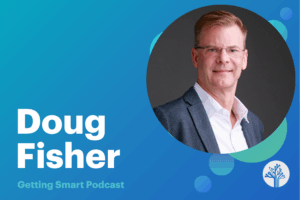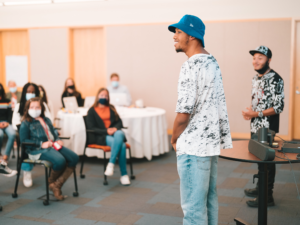How Confirmation Bias Hijacks Student Thinking — and What Educators Can Do About It

I spend an inordinate amount of time every day on Tiktok, which means the algorithm knows me quite well, filling my For You Page (FYP) with content likely to keep me glued to the screen for hours.
TikTok, as frequent readers of this space know, isn’t my trusted source for verified information. I use it more as an early warning system — an algorithmically curated glimpse into rising cultural narratives. Even this passive consumption influences how I process information
I fear, though, a systematic error in thinking is fatefully disrupting my primary purpose for watching TikTok. If confirmation bias, which can be described as a cognitive process where people tend to seek, interpret, and remember information that supports their existing beliefs or opinions, assails my logic-hardened brain and colors my understanding of the world, what does it do to the more impressionable brains of our students?
This mental shortcut helps the mind process information quickly, but it can distort reality and reinforce stereotypes or misconceptions. The programmers who write the algorithms that drive TikTok and other social media platforms are well aware of this human weakness. These algorithms analyze users’ behaviors, likes, and interactions to curate feeds that increasingly reflect existing beliefs, often at the expense of intellectual diversity and exposure to opposing viewpoints.
I feel strongly that in our drive to develop and enhance the critical thinking skills of students we should be tightly focused on giving them the ability to identify their own confirmation biases. This process should equip students with strategies that allow them to search and evaluate information using a filtration system that evaluates for bias what they see, read, and hear. Forewarned is forearmed.
Confirmation Bias – A Primer
I encountered explanations of confirmation bias for the first time during an intense flirtation with the field of behavioral economics, devouring books by Richard Thaler (Nudge), Steven Levitt (Freakonomics), and Daniel Kahneman (Thinking Fast and Slow).
My understanding deepened when I began doing research for a blog called Education Has an Alignment Problem and AI Could Make It Worse. That exploration helped clarify how algorithmic design – specifically through the lens of confirmation bias – was contributing to the misalignment between student needs and business outcomes. I knew social media platforms were modifying their algorithms to increase user engagement, but it took me additional reading to understand that the mechanism behind this approach was confirmation bias.
It would be difficult to find an article written during the last three years that didn’t advocate the importance of teaching critical thinking skills in the age of AI. During my TikTok adventures I began to wonder if any of the critical thinking frameworks being used in K-12 explicitly addressed the topic of confirmation bias and provided guidance on how to recognize these biases and counteract them.
This was not a fruitful line of inquiry, though I did find two that could easily supplement existing models. Tim Van Gelder’s Argument Mapping Model trains learners to diagram arguments visually to detect weaknesses in reasoning and expose hidden biases. Cambridge English’s Bias Battle Framework, from its Virtual Training Team’s Critical Thinking curriculum, integrates bias recognition as a metacognitive skill.
Identifying and Fighting Confirmation Bias
I frequently find the need to reset my algorithm (and FYP feed), which I do by logging out and deleting my search history. I then engage in random searches that bear no resemblance to my usual inquiries. This tends to remove temporary distractions that mutate my feed in directions shaped by emotional triggers or fleeting interests, which the algorithm interprets as preference. Example: I wanted the Dodgers to win the World Series; TikTok feeds me tons of pro-Dodgers content. This tactic is low-hanging fruit in the battle against confirmation bias.

Here are 10 strategies, culled from a wide variety of sources, that can increase your students’ ability to identify and control confirmation bias. I will map them against domains in Bloom’s Taxonomy to show their linkage to a popular K-12 understanding of critical thinking.
- See Disconfirming Evidence: Actively search for information, arguments, or data that directly contradict current beliefs or hypotheses (Bloom: Analyzing and Evaluating).
- Employ the Devils’ Advocate Role: When consuming content, deliberately take on the role of someone who holds the opposite viewpoint. Try to understand their logic and strongest arguments (Bloom: Understanding and Analyzing).
- Curate a Diverse Social Feed: Intentionally follow sources, people, and groups that represent a broad range of perspectives (Bloom: Applying).
- Fact-Check the Source, Not Just the Claim: Don’t just verify a piece of information – investigate the source’s reputation, funding, methodology, and biases (Bloom: Evaluating).
- Monitor Emotional Responses: Notice when a piece of content makes you feel intensely emotional. Strong emotions often lower your critical guard and make you more susceptible to accepting information that validates pre-existing feelings (Bloom: Understanding an Analyzing).
- Practice the Three-Source Rule: Before accepting a major claim or fact, try to verify it by at least three different, credible and non-related sources (Bloom: Evaluating).
- Question the Search Engine’s Role: Be aware that search engines and social media platforms personalize results based on your past online behavior. To combat this, use incognito or private browsing mode; switch search engines (Bloom: Analyzing).
- Deconstruct the Why Behind the Belief: Take time to journal or reflect on why you hold a particular strong belief (Bloom: Analyzing).
- Focus on Data and Method Over Conclusions: When reading a report or story, ignore the headline and conclusion on the first read. Examine instead the data, sample size, and research methods (Bloom: Analyzing and Evaluating).
- Engage in Constructive Dialogue: Instead of debating to win or flaming someone, engage with others holding different views in an attempt to learn (Bloom: Creating and Evaluating).
These strategies overwhelmingly target the higher order thinking skills necessary for critical thinking and will go far in directly focusing on the mitigation of confirmation bias. If we anchor them to an activity students engage in on a daily basis and cross-reference them with the dominant domains of K-12 curriculum, we may have a winner.
Embedding Critical Thinking in the Curriculum
It seems like a new AI literacy framework drops every few months. I’ve read each new release, focusing mostly on what I see to be the defining argument among the competitors: Where does AI literacy reside in the curriculum? Should it live in STEM, or English/Language Arts, or computer science and coding classes? Or, should it be spread among the disciplines (DSAIL, for instance), much the way the Writing Across the Curriculum was designed to make literacy a key feature of all instruction? There is a third way – a hybrid model advocated for by organizations such as Digital Promise.
We’ve had a similar debate about the teaching of critical thinking skills. I am cheered by the idea that debate seems to have settled on the belief that critical thinking should be taught within and across all disciplines. This idea is reflected in frameworks from OECD and UNESCO. In fact, a cross-disciplinary study published this year argues that critical thinking is domain-specific in its application.
Let’s use strategy No. 9 (Focus on Data and Methods Over Conclusions) from above and take a brief look at how we take a discipline-specific approach with sixth graders, the level I taught for eight years.
Science: Teach students that when forming a hypothesis they must plan to look for results that don’t fit their prediction.
Math: Instruct students to use inverse operations or check the context of a problem to find a reason why their calculated answer might be incorrect.
Social studies: Guide students to find an account or document that tells the other side of a historical event or conflict to see why people disagreed.
English/language arts: Encourage students to look for strong evidence that weakens the main idea or argument presented in a persuasive essay or advertisement.
If you are looking for more examples of how to go discipline-specific with the strategies I enumerated earlier, simply insert your selection into a chatbot of your choice and prompt it to create an activity for your subject area and grade level. Be sure to anchor it in the lived experience of your students.
There will be doubters, in part because some educators may be unaware of the tricks their own mind can play on them. If you don’t think confirmation bias is a big problem I ask you to do this simple self-check of your social media feed tonight. Search your favorite platform (Instagram, TikTok, Facebook, etc.) for a contentious topic and then read the top 10 results. Analyze these results to see if all or nearly all them present the same viewpoint. I bet you dollars to donuts they do.
If we want our students to thrive in an AI-mediated world, we can’t just teach them to think critically. We must teach them to think about how they think. Confirmation is a powerful force, but with awareness, strategy, and curricular integration, we can help students become agile, adaptive thinkers who welcome complexity over comfort.







0 Comments
Leave a Comment
Your email address will not be published. All fields are required.